Oxaceprol
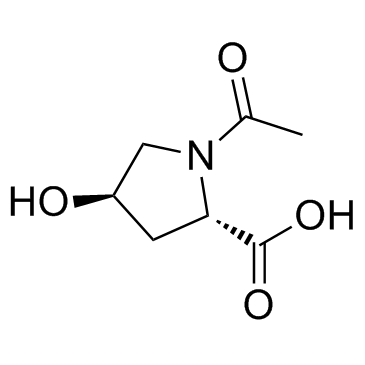
Oxaceprol structure
|
Common Name | Oxaceprol | ||
|---|---|---|---|---|
| CAS Number | 33996-33-7 | Molecular Weight | 173.167 | |
| Density | 1.4±0.1 g/cm3 | Boiling Point | 442.1±45.0 °C at 760 mmHg | |
| Molecular Formula | C7H11NO4 | Melting Point | 132-133 °C (dec.)(lit.) | |
| MSDS | Chinese USA | Flash Point | 221.2±28.7 °C | |
| Symbol |

GHS05 |
Signal Word | Danger | |
Use of OxaceprolOxaceprol is an anti-inflammatory drug used in the treatment of osteoarthritis. Oxaceprol markedly inhibited inflammatory cell infiltration and bone damage in the adjuvant-injected paw. oxaceprol was effective at inhibiting periarticular soft tissue inflammation.[1] IV Injection: 50mg/kg.[2] |
| Name | Oxaceprol |
|---|---|
| Synonym | More Synonyms |
| Description | Oxaceprol is an anti-inflammatory drug used in the treatment of osteoarthritis. Oxaceprol markedly inhibited inflammatory cell infiltration and bone damage in the adjuvant-injected paw. oxaceprol was effective at inhibiting periarticular soft tissue inflammation.[1] IV Injection: 50mg/kg.[2] |
|---|---|
| Related Catalog | |
| References |
| Density | 1.4±0.1 g/cm3 |
|---|---|
| Boiling Point | 442.1±45.0 °C at 760 mmHg |
| Melting Point | 132-133 °C (dec.)(lit.) |
| Molecular Formula | C7H11NO4 |
| Molecular Weight | 173.167 |
| Flash Point | 221.2±28.7 °C |
| Exact Mass | 173.068802 |
| PSA | 77.84000 |
| LogP | -2.04 |
| Vapour Pressure | 0.0±2.4 mmHg at 25°C |
| Index of Refraction | 1.561 |
| Symbol |

GHS05 |
|---|---|
| Signal Word | Danger |
| Hazard Statements | H318 |
| Precautionary Statements | P280-P305 + P351 + P338 |
| Personal Protective Equipment | dust mask type N95 (US);Eyeshields;Gloves |
| Hazard Codes | Xi: Irritant; |
| Risk Phrases | R41 |
| Safety Phrases | S26-S36 |
| RIDADR | NONH for all modes of transport |
| WGK Germany | 3 |
| HS Code | 2933990090 |
|
~% 
Oxaceprol CAS#:33996-33-7 |
| Literature: Journal of the American Chemical Society, , vol. 76, p. 139,141 |
|
~% 
Oxaceprol CAS#:33996-33-7 |
| Literature: Journal of the American Chemical Society, , vol. 76, p. 139,141 |
|
~% 
Oxaceprol CAS#:33996-33-7 |
| Literature: Journal of the American Chemical Society, , vol. 76, p. 139,141 |
|
~% 
Oxaceprol CAS#:33996-33-7 |
| Literature: Journal of the American Chemical Society, , vol. 76, p. 139,141 |
|
~% 
Oxaceprol CAS#:33996-33-7 |
| Literature: Journal of the American Chemical Society, , vol. 76, p. 139,141 |
|
~% 
Oxaceprol CAS#:33996-33-7 |
| Literature: Journal of the American Chemical Society, , vol. 76, p. 139,141 |
|
~% 
Oxaceprol CAS#:33996-33-7 |
| Literature: Journal of the American Chemical Society, , vol. 76, p. 139,141 |
|
~% 
Oxaceprol CAS#:33996-33-7 |
| Literature: Journal of the American Chemical Society, , vol. 76, p. 139,141 |
|
~% 
Oxaceprol CAS#:33996-33-7 |
| Literature: Journal of the American Chemical Society, , vol. 76, p. 139,141 |
| Precursor 7 | |
|---|---|
| DownStream 2 | |
| HS Code | 2933990090 |
|---|---|
| Summary | 2933990090. heterocyclic compounds with nitrogen hetero-atom(s) only. VAT:17.0%. Tax rebate rate:13.0%. . MFN tariff:6.5%. General tariff:20.0% |
|
Oxaceprol, an atypical inhibitor of inflammation, reduces leukocyte adherence in mouse antigen-induced arthritis.
Acta Orthop. Scand. 72(3) , 293-8, (2001) Oxaceprol (N-acetyl-L-hydroxyproline), an atypical inhibitor of inflammation, is an established drug forjoint disease without serious side-effects. Recent studies have emphasized that oxaceprol has an... |
|
|
Determination of oxaceprol in rat plasma by LC-MS/MS and its application in a pharmacokinetic study.
J. Pharm. Biomed. Anal. 54(1) , 173-8, (2011) A sensitive method for the quantification of oxaceprol in rat plasma using high-performance liquid chromatography-tandem mass spectrometry (LC-MS/MS) was developed. Sample pretreatment involved a simp... |
|
|
[Assessment of the placebo effect of symptomatic slow-acting anti-arthritics].
Presse Med. 27(5) , 211-4, (1998) Assess the importance of the mid-term placebo effect of symptomatic slow acting drugs given for osteoarthritis.We analyzed six controlled trials available in the literature. Trial duration ranged from... |
| AHP-200 |
| trans-1-Acetyl-4-hydroxy-1-proline |
| Jonctum |
| (2S,4R)-1-acetyl-4-hydroxypyrrolidine-2-carboxylic acid |
| N-Acetyl-L-hydroxyproline |
| Oxaceprol |
| L-Proline, 1-acetyl-4-hydroxy-, (4R)- |
| (2S,4R)-N-acetyl-4-hydroxyproline |
| CO-61 |
| trans-l-prolin |
| (4R)-1-Acetyl-4-hydroxy-L-proline |
| (2S,4R)-1-acetyl-4-hydroxy-2-pyrrolidinecarboxylic acid |
| MFCD00037339 |
| (-)-1-Acetyl-4-hydroxy-L-proline |
| AC-HYDROXYPROLINE |
| Hyp4001Ac-Hyp-Oh |
| N-acetyl-trans-4-hydroxy-L-proline |
| EINECS 251-780-6 |
| (2S,4R)-1-acetyl-4-hydroxy-proline |
| 1-acetyl-trans-4-hydroxy-L-proline |
| N-AC-L-HYP |
| Ac-L-Hyp-OH |
| AC-HYP-OH |
| N-Acetyl-L-4-Hydroxyproline |
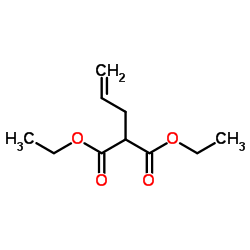

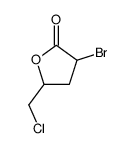
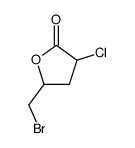

![ethyl 5-[(1,3-dioxoisoindol-2-yl)methyl]-2-oxo-oxolane-3-carboxylate structure](https://image.chemsrc.com/caspic/328/6284-28-2.png)

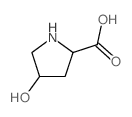
 CAS#:618-27-9
CAS#:618-27-9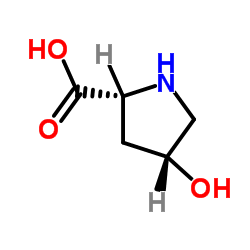 CAS#:2584-71-6
CAS#:2584-71-6
